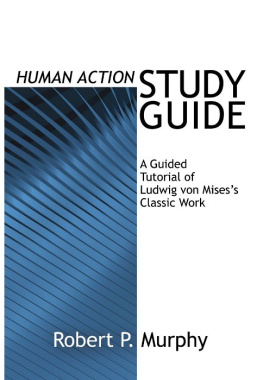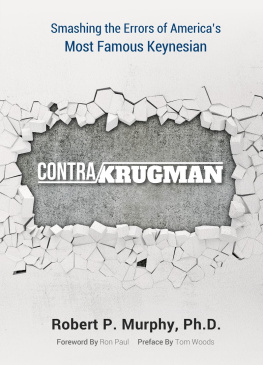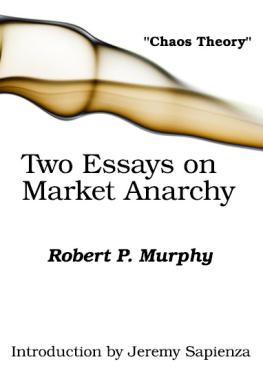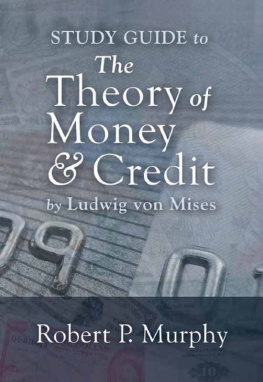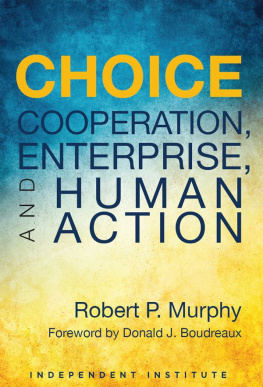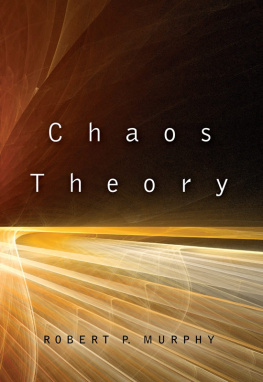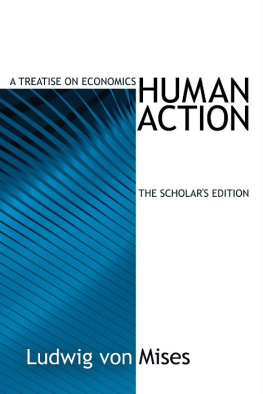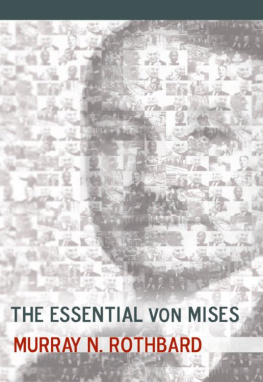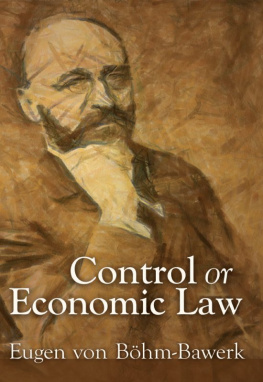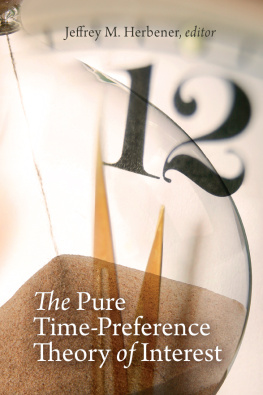STUDY GUIDE
TO
HUMAN ACTION
A TREATISE ON ECONOMICS
SCHOLARS EDITION
LUDWIG VON MISES
ROBERT P. MURPHY
& AMADEUS GABRIEL


Copyright 2008 by Ludwig von Mises Institute
All rights reserved. Written permission must be secured from the publisher to use or reproduce any part of this book, except for brief quotations in critical reviews or articles.
Published by the Ludwig von Mises Institute
518 West Magnolia Avenue, Auburn, Alabama 36832-4501
mises.org
ISBN: 978-1-933550-38-1
PREFACE
Murray Rothbards massive Man, Economy, and State with Power and Market is the best single book for a fairly complete exposition of the modern Austro-libertarian worldview. Although Rothbards prose is characteristically crystal clear, even so the books daunting size intimidated many newcomers, leading to the regrettable situation where many self-identified Austrians hadnt read one of the most important books in the tradition. To address this grave condition, the Ludwig von Mises Institute commissioned me to write a study guide for MES.
The MES study guide was a success. It allowed new readers to test the waters before diving in, and at the same time it was a useful reference for experienced readers. I personally would use the guide whenever I prepared a lecture touching on some aspect of Rothbards treatise.
The Mises Institute now hopes to do the same with the present study guide to Ludwig von Misess Human Action. I will not here give a history or description of Misess magnum opus, for those tasks are performed much more ably in the Introduction to the Scholars Edition by Jeffrey M. Herbener, Hans-Hermann Hoppe, and Joseph T. Salerno. Suffice it to say, one cannot really claim to be an Austrian economistcertainly not a Misesian!without reading Human Action. (And yes, you really need to read it cover to cover. Its all good.)
The format of this study guide is straightforward. Each chapter starts with a summary that follows the numbered section headings and italicized subheadings as they appear in Misess text. Then it provides an explanation of Why It Matters, giving historical context and/or explaining the role that the chapter serves in the book. (One of the joys of writing this study guide was my discovery that there was a very systematic arrangement of the chapters and parts of the book, which I had not noticed during prior readings.) The next section provides Technical Notes, which address difficulties in Misess arguments, and clarifies subtle points. When relevant, this section also relates Misess work to mainstream economics, for the benefit of graduate students or professors.
Finally, each chapter ends with a detailed list of Study Questions, the bulk of which had been independently prepared by Amadeus Gabriel. I was very pleased to learn of Mr. Gabriels efforts, because his questions ensure that the reader is grasping the essential points (some of which had to be ignored in the summary section), but also because his contribution allowed the completion of this study guide much sooner than would otherwise have been possible. (And as we all know, a present study guide is preferred to a future study guide.)
I hope the present guide encourages more people to read what is arguably one of the most important books written in the 20th century.
ROBERT P. MURPHY
Nashville, Tennessee
December 2008
Part OneHuman Action
CHAPTER I
FUNDAMENTALS OF HUMAN ACTION
Chapter Summary
1. PURPOSEFUL ACTION AND ANIMAL REACTION
Human action is purposeful behavior. The distinguishing feature of action is that the observer imputes a goal to the actor. Action is different from purely reflexive behavior. A man may flinch after a loud noise. This is not necessarily action in the Misesian sense.
Praxeology is the science of action as such. That is, praxeology as a field contains all results that can be deduced from the fact that people have ends (i.e., goals), and adopt means of trying to achieve them. The specific content of the ends, and whether the means chosen are suitable, lie outside the scope of praxeology.
Every action is a choice, where the actor selects one alternative that he prefers to another.
2. THE PREREQUISITES OF HUMAN ACTION
In order for action to occur, the actor must be in a state of uneasiness or dissatisfaction. (If he were perfectly content, he would not act.) Along with the uneasiness, the actor must be able to imagine a more satisfactory state. Finally, the actor must believe that purposeful behavior has the power to remove or reduce the uneasiness. If this last condition were lacking, the unhappy person would not act, since he would be unable to conceive of any way to improve his situation.
On Happiness
It is acceptable to view action as mans striving for happiness. However, such a claim is liable to misinterpretation. In praxeology, happiness (or utility, or satisfaction) is a purely formal term, defined entirely by the subjective goals of the individual actor.
On Instincts and Impulses
Certain schools of thought reject praxeology as rationalistic. Instead, these critics claim that people behave on instincts, just like other animals. There are two problems with this view. First, even if the critics were correct, and humans really did act on the basis of instincts, nonetheless praxeology would still be valid. Acting on instinct is still action, and praxeology studies action as such, regardless of its underlying causes. A second problem with the instinct argument is that, unlike lower animals, humans clearly can suppress their biological urges. A martyr can choose to go to the stake rather than renounce his beliefs (thus violating the instinct of survival), and cash-strapped couples can use their reason to avoid the instinct to reproduce.
3. HUMAN ACTION AS AN ULTIMATE GIVEN
By its very nature, science will never be able to explain everything. Science proceeds by pushing back the limits of ignorance, but at any point a scientific discipline must start with assumptions or givens, and then proceed (scientifically!) from there. In the scientific study of action, the ultimate starting point is action itself. Praxeology simply takes it for granted that action exists, and traces out the implications of this fact.
All studies of human actions must rely on methodological dualism. The second half of this phrasedualismsimply means that there are apparently two different realms of causality. On the one hand is the physical material world, the structure and laws of which the physicists, chemists, and so on can describe with greater and greater accuracy. On the other hand, there is always the mental or subjective world, including thoughts, emotions, desires, and so forth. The first word in the phrasemethodologicalsignifies that Mises is not taking a stand on the ultimate philosophical dispute. That is, Mises concedes that the materialists might be correct; perhaps every thought really can be directly attributed to a configuration of atoms. Nonetheless, even if this is true in some cosmic sense, Mises argues that at present the mind-body connection is so poorly understood that praxeologists must adopt dualism if only for pragmatic reasons. It certainly seems as if people have free will and can truly choose among alternatives.

